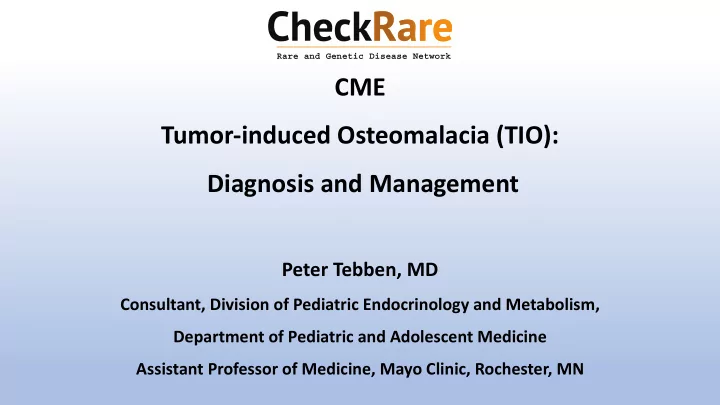

CME Tumor-induced Osteomalacia (TIO): Diagnosis and Management Peter Tebben, MD Consultant, Division of Pediatric Endocrinology and Metabolism, Department of Pediatric and Adolescent Medicine Assistant Professor of Medicine, Mayo Clinic, Rochester, MN
Outline • Describe clinical features of tumor induced osteomalacia • Brief review of phosphate homeostasis • Identify an approach to evaluation of the patient with hypophosphatemia • Review management of the patient with tumor induced osteomalacia
Case Study • A 70-year-old man presents for evaluation after feeling unwell for 7 years. • He initially experienced right knee pain that progressed to bilateral knee, hip, and foot pain, as well as muscle weakness • He developed numerous stress fractures and ambulation became difficult • He eventually required a cane and electric scooter for mobility and was unable to perform many of the activities he was accustomed to—including dancing with his wife • Treatment for vitamin D deficiency did not resolve his pain and fractures • Many years after symptom onset, serum phosphorus was measured and the diagnosis of TIO considered
Tumor Induced Osteomalacia • Rare paraneoplastic condition characterized by chronic hypophosphatemia and osteomalacia • Offending tumor can be found anywhere from head to toe • Muscle weakness, bone pain and fractures are typical presenting symptoms • Delay in diagnosis often for several years after onset of symptoms is common • TIO is a curable disease Florenzano P, et al. (2020) Cal. Tissue Int. Boland JM, et al. (2018) J of Endo. Investigation Vol 41(10) Salassa RM, et al. (1970) NEJM Vol 283(2)
Phosphate Homeostasis Intake Absorption Formation Extracellular Pool Excretion Resorption Reabsorption Filtered NaPi 2b PTH FGF23 NaPi 2a NaPi 2c Increase urine phos Increase urine phos • • Increase 1,25(OH) 2 D Decrease 1,25(OH) 2 D • • Bone resorption • Urine Phosphorus excretion
Hypophosphatemia - Etiology Not enough in… Redistribution… Too much out…
Not enough in… Redistribution… Shift to intracellular Low phosphorus intake • compartment Malabsorption • Insulin therapy for DKA • IBD, short bowel syndrome, chronic • Acute respiratory alkalosis • diarrhea Refeeding syndrome • Phosphate binders • Phosphate uptake by bone Hungry bone syndrome (post- • parathyroid surgery)
Too much out… Parathyroid mediated FGF23 mediated • Hyperparathyroidism • Tumor induced osteomalacia (TIO) • Vitamin D deficiency • X-linked hypophosphatemia (XLH) • Nutritional, enzyme deficiency, • Iron infusions VDR mutation • ADHR • Fibrous dysplasia/McCune Albright syndrome • Others Renal Proximal Tubule Defects (non-FGF23 mediated) • Renal Fanconi • Sodium-phosphate transporter mutations
Low Serum Phosphorus History Redistribution Assess urine phosphorus High urine phos Low Urine Phos (↓TmP/GFR) (↑TmP/GFR) Normal PTH High PTH Low/Nl High 1,25(OH) 2 D 1,25(OH) 2 D PTH/Ca/Vit D Non-FGF23 Not enough in… FGF23 mediated disorder mediated
Biochemical Findings of TIO Lab Test Value Serum phosphorus Low Serum calcium Normal Parathyroid hormone Normal to slightly elevated 25-hydroxyvitamin D 3 Variable 1,25-dihydroxyvitamin D 3 Normal or low FGF-23 Normal or elevated Urine phosphorus Inappropriately high* * Elevated fractional excretion of phosphorus or low TMP/GFR
Evaluation of the patient with TIO FGF23 mediated • Tumor induced osteomalacia (TIO) • X-linked hypophosphatemia (XLH) • Iron infusions • ADHR • Fibrous dysplasia/McCune Albright syndrome • Others
Tumor Identification • Careful physical examination – including skin • Functional whole body imaging 68 Ga-Dotatate PET/CT • • Octreotide scan 18 FDG PET/CT • • Whole body sestamibi scan • Anatomical imaging • CT • MRI • Ultrasound • Venous Sampling (FGF-23 measurement) • Limited role if functional and anatomic imaging is negative El-Maouche D, (2016) J Clin Endo Metab. Vol 101(10) Breer S, (2014) Bone. Vol 64 Hodgson SF, et al. (2006) Endo Practice. Vol 12(1)
Treatment Options • Surgery • Treatment of choice when tumor is identified and can be resected • Medical management • Phosphate and active vitamin D (calcitriol) • Anti-FGF23 antibody therapy
Phosphate and Calcitriol Typical adult dose range • Phosphorus: 500 – 2000+ mg/day in divided doses • Calcitriol: 0.5 – 2 mcg per day Too much calcitriol Too much phosphate • Hypercalcemia • Diarrhea • Hypercalciuria • Hypocalcemia • Nephrocalcinosis • Hyperparathyroidism Phosphorus Calcitriol • Nephrolithiasis • Secondary • Tertiary
Tumor Induced Osteomalacia Normal Physiology Phosphorus reabsorption X ↑FGF23 NaPi 2a Normal FGF23 Tumor NaPi 2c Urine Phosphorus excretion Excess Phosphorus excretion Carpenter TO, et al. (2020 ) J of the Endocrine Society. Vol 4, Abstract Supplement
Anti-FGF-23 Antibody Therapy Phosphorus reabsorption ↑FGF23 X NaPi 2a Tumor NaPi 2c Urine Phosphorus excretion Carpenter TO, et al. (2020 ) J of the Endocrine Society. Vol 4, Abstract Supplement
Key Take Away Points • Tumor induced osteomalacia is a rare and often devastating condition • Measure serum phosphorus in patients with unexplained musculoskeletal complaints • Basic laboratory tests can determine cause of low phosphorus • Tumor resection is curative • If tumor is not found or not able to be removed, medical management can improve/resolve symptoms • Keep looking if tumor not initially found!
Recommend
More recommend